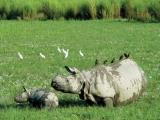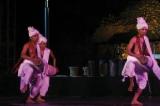Archives
NE Tourism
However, before such questions are raised, it is pertinent to mention a few fundamentals that one should keep in mind while discussing tourism. First, tourism is not an end in itself; it is a means to an end. And that end is public welfare. That is why ‘people’ are so crucial to any discussion on tourism. It also follows that the role of tourism should be seen in the background of the overall socio-economic parameters of the place. Tourism should be an integrated input in the development planning of the place - integrated with the many sectors which make tourism possible. And quite often it turns out to be a very important input. Yet the tourism protagonists should refrain from projecting it as the only panacea for the economic ills.
 It is the economic situation in the north east which is worrisome and the ‘North East Region Vision 2020’of the Ministry of DoNER and the North Eastern Council makes no bone about it. The region of 39 million people (at the time of the Report) 86% of whom are in rural areas, with 97% of the land under food grain cultivation with low productivity, had, on average State Gross Domestic Product (SGDP) 4 per cent above the national average Gross Domestic Product (GDP) at the time of independence. After 50 years of development planning the average SGDP has fallen to 31 per cent below the national average. Other important indicators like Maternal Mortality Rate (MMR) and Infant Mortality Rate (IMR) are shockingly above the national average. The process of catching up will require increasing the growth rate from the present rate of 4 per cent to about 16 per cent by the 13th Plan and will require capital investment of around Rs 13 lakh crore. It is a daunting task and needs a growth strategy which is focussed and multi-pronged. The Vision document and many other expert reports including the Assam Development Report of the Planning Commission argue for a strategy based on ‘Comparative Advantage’ of the region. And this strategy puts sustainable tourism at the core of the development agenda.
It is the economic situation in the north east which is worrisome and the ‘North East Region Vision 2020’of the Ministry of DoNER and the North Eastern Council makes no bone about it. The region of 39 million people (at the time of the Report) 86% of whom are in rural areas, with 97% of the land under food grain cultivation with low productivity, had, on average State Gross Domestic Product (SGDP) 4 per cent above the national average Gross Domestic Product (GDP) at the time of independence. After 50 years of development planning the average SGDP has fallen to 31 per cent below the national average. Other important indicators like Maternal Mortality Rate (MMR) and Infant Mortality Rate (IMR) are shockingly above the national average. The process of catching up will require increasing the growth rate from the present rate of 4 per cent to about 16 per cent by the 13th Plan and will require capital investment of around Rs 13 lakh crore. It is a daunting task and needs a growth strategy which is focussed and multi-pronged. The Vision document and many other expert reports including the Assam Development Report of the Planning Commission argue for a strategy based on ‘Comparative Advantage’ of the region. And this strategy puts sustainable tourism at the core of the development agenda.
 More importantly, the economic situation also indicates the type of tourism that should be promoted - tourism based on exploitation of the rural resources, tourism linked to the great craft and cultural traditions of the region, tourism that helps the large number of women who are engaged in the creation of beautiful handlooms. The region has 50 per cent of the looms of the country and 95 per cent of the weavers in the north east are women. The north east has a strong bamboo culture - lifestyle of people revolving around the masterly weaves in cane and bamboo. The Vision document refers to a United Nations Industrial Development Organization (UNIDO) report that exploitation of bamboo can give the region Rs 5000 crores in the next 10 years. Sample surveys by the Ministry of Tourism in Kerala and Rajasthan have established that 90 to 95 per cent of the income of artisans came from tourism and the earnings went up many times during peak tourism seasons. United Nations-World Tourism Organization (UNWTO) and EU surveys have shown that 30 per cent of the international tourists travel solely for cultural experiences. What a treasure house we have still unexploited!
More importantly, the economic situation also indicates the type of tourism that should be promoted - tourism based on exploitation of the rural resources, tourism linked to the great craft and cultural traditions of the region, tourism that helps the large number of women who are engaged in the creation of beautiful handlooms. The region has 50 per cent of the looms of the country and 95 per cent of the weavers in the north east are women. The north east has a strong bamboo culture - lifestyle of people revolving around the masterly weaves in cane and bamboo. The Vision document refers to a United Nations Industrial Development Organization (UNIDO) report that exploitation of bamboo can give the region Rs 5000 crores in the next 10 years. Sample surveys by the Ministry of Tourism in Kerala and Rajasthan have established that 90 to 95 per cent of the income of artisans came from tourism and the earnings went up many times during peak tourism seasons. United Nations-World Tourism Organization (UNWTO) and EU surveys have shown that 30 per cent of the international tourists travel solely for cultural experiences. What a treasure house we have still unexploited!
Everyone talks about these potentials, everyone professes help to exploit them and yet like Alice in Wonderland we seem to be running faster to remain in the same place. North east tourism needs a professional, not ad hoc, approach. The north east has a fortunate abundance of ‘Master Plans’ but are the plans professionally implemented? Are the policy makers convinced of the role that tourism can play in development and poverty eradication? Do they give tourism its due in the planning process or is tourism pursued as a stand- alone activity? Or we are just happy about what we have achieved?
Proper planning implies a proper management approach. If tourism is to be treated as a ‘raw material’ for development we must know what we have. Then we must have the organisational capacity to harness that resource. We must also have the financial capacity to develop it.
 We broadly and proudly talk about our great tourism attractions. The Government of India has called the region a ‘paradise unexplored’. But planning must start with a benchmark survey of what we have so that we can categorise these according to our perceived importance and availability of financial resources. The focus always has been on the tangible and physical heritage and resources rarely going beyond that to the depth of invaluable intangible heritage of music, dance, cuisine, folk lore, lifestyle - traditions that can provide the unique experience that the tourists look for.
We broadly and proudly talk about our great tourism attractions. The Government of India has called the region a ‘paradise unexplored’. But planning must start with a benchmark survey of what we have so that we can categorise these according to our perceived importance and availability of financial resources. The focus always has been on the tangible and physical heritage and resources rarely going beyond that to the depth of invaluable intangible heritage of music, dance, cuisine, folk lore, lifestyle - traditions that can provide the unique experience that the tourists look for.
Numbers certainly are not the most important factors in tourism development but they are important. They help in policy formulations as indicators. The numbers for the north east are dismal. The north east received only 53 lakh domestic visitors (as distinct from arrivals) against the national total of 7402 lakh and 48000 foreign visitors against 178 lakh for the whole country.
Certainly, the statistics can have many loopholes. The north east must decide on the type of tourists it would like to attract and the rest of the policy will follow. But in any case if we have to progress from the dismal numbers we will need to do a lot on accommodation. Again, the Ministry of Tourism figures are pathetic. There are only 1752 hotel rooms as against the all India figure of 1,18,000 rooms in the recognised category. Most certainly there are many more rooms in the region, but apparently they are not evaluated for recognition for star category by the government. There is therefore no quality audit of the most important requirement for tourist flow - decent accommodation.
MOT has identified a few circuits for development in the region. And certainly air connectivity to the region and inside the region has improved a lot. But if a concept of north east tourism - integrated and easy flowing - has to develop, much better and greater road connectivity is needed. Even if the roads exist, in whatever condition they are and the tourists are willing to brave them, where are the most needed wayside facilities - or at least decent toilets and hygienic eating places?
 A lot of improvements in tourism infrastructure are required. But tourism is primarily a private sector driven industry. It is necessary for the governments to come out with specific PPP initiatives. It is also necessary to devise suitable and pragmatic land policies. The NEIPP 2007 has outlined incentives for entrepreneurs. It is necessary to take stock – how investor friendly is its implementation? What progress it has made. The Assam Tourism Policy has mentioned some excellent initiatives like reimbursement of value added tax, luxury tax, State Capital Investment Subsidy, etc. Are they operational?
A lot of improvements in tourism infrastructure are required. But tourism is primarily a private sector driven industry. It is necessary for the governments to come out with specific PPP initiatives. It is also necessary to devise suitable and pragmatic land policies. The NEIPP 2007 has outlined incentives for entrepreneurs. It is necessary to take stock – how investor friendly is its implementation? What progress it has made. The Assam Tourism Policy has mentioned some excellent initiatives like reimbursement of value added tax, luxury tax, State Capital Investment Subsidy, etc. Are they operational?
There are many areas in which PPP can play a pivotal role. Good tourist transport is practically non-existent. The abundance of water bodies and rivers that we have can be harnessed to make water sports a major attraction. Amusement parks, similarly, have immense potential. A lot can be done imaginatively to exploit the grand beauty of the majestic Brahmaputra and to develop Guwahati – the gateway to the north east, as the most beautiful city in the country. And with the growing interest in the north east and the likely flow of investment into the region, it will be a good opportunity to position the region as an attractive MICE destination. With a little bit of imagination and with a bit of ‘will’ the north east can be transformed through development of sustainable tourism.
We should begin the journey at the end i.e. implementation, and end with implementation alone. And I always end my north east musings with the words of philosopher Albert Camus-”Don’t wait for the Day of Judgement, MonCher. It takes place everyday.”

